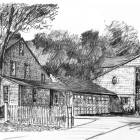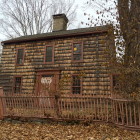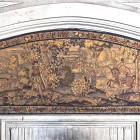News
‘One of the Last Remaining Artifacts of New Canaan’: Preservationists Explore Ways To Save Historic Ferris Hill Road Home
|
Mobilized by the very real possibility that a historic Ferris Hill Road home will be razed, local preservationists and other experts are working with its owner and touting the 2.14-acre property’s potential for types of development that would still save the antique structure. A demolition sign went up Wednesday at 8 Ferris Hill Road (listed as 441 Canoe Hill Road in the assessor’s database), one week after its owner applied for a permit to raze the 1735-built home. Now is a critical time for preservation advocates, before a 15-day window to object to the demolition runs out and a decision likely is left with a municipal committee. Though the home’s owner could not be reached for comment, he has said that demolition appears to be the only possible way to develop the property he now regrets purchasing more than two years ago. Yet one local expert, Robert Dean of New Canaan-based Robert Dean Architects, a firm that’s been practicing here for 30 years, said there are three basic ways that emerged when it comes to preserving an antique structure such as this in the face of development: Move it, sustain it in place and build around it, or sustain it in place and add onto it (more on those options below).





